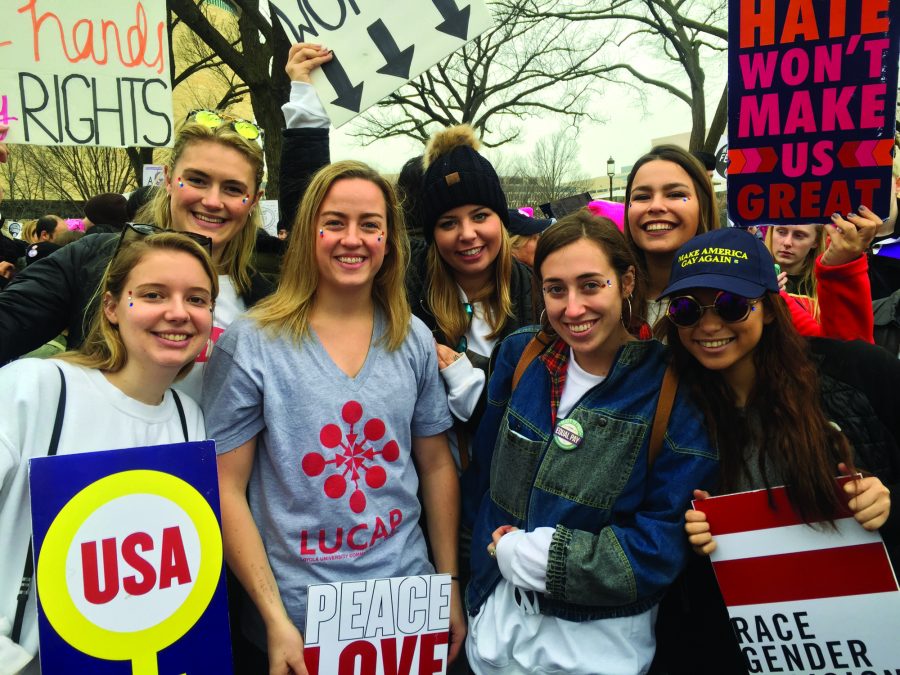Opinion: What to learn from a student at the Women’s March in Washington
Several Loyola students carpooled from New Orleans to Washington DC to participate in the Women’s March on Saturday, Jan. 21. These students were some of the 500,000 protesters at the capital, the largest in its history. Kate O’Leary, biology senior, points out the power and needed improvements for protest. Photo credit: Dannielle Garcia
February 2, 2017
The Women’s March on Washington was an unprecedented mobilization of marginalized power. Roughly 500,000 people marched through Washington in solidarity, celebrating equality and speaking out against injustice.
Although women must submit to implicit and explicit forms of oppression every day, that day I saw a power in the struggle of subordinate groups. The oppression experienced by each woman is distinct but connected, and it often leads to the most potent antidote to injustice: empathy.
The Women’s March was a testament to the power and productivity of empathy. It is an inclusive emotion that strives to understand others, and it is capable of combating much of what fuels Trump’s policies: fear and discrimination.
Empathy motivated this march — women were there for themselves and each other.

The atmosphere was largely positive (although we must not fail to recognize that peaceful protest requires police cooperation, which was more easily accessed because the crowd was mostly white). There was little to no negativity or aggression among marchers, but instead spontaneous dance parties broke out outside the White House, people shouted out praise at our signs, and grandfathers marched alongside their young granddaughters.
At its best, the Women’s March was a collective and poignant cry of dissent, giving a voice to all those who feel invalidated by Trump’s platform.
However, it would be unfair to history and an oversimplification for me to say the Women’s March was a hallmark of inclusivity.
As we marched down Pennsylvania Avenue, a group of people of color stood on the sidewalk with signs reminding us that the majority of white women voted for Trump. They were marching with us, but also holding us accountable.
The Women’s March was started by white women, and although it attracted people from many different backgrounds, it also repelled many people who felt unwelcome or unheard.
The crowd at the march was also overwhelmingly white. Privilege is not a marker of personal failure, but a social one, and we should not be ashamed to acknowledge it. Refusing to acknowledge the privilege we have is to lack empathy and tacitly participate in the oppression of others.
One thing I found problematic was how many signs were centered around female reproductive organs because focusing the message of the march on cisgender women is divisive and excludes transgender women.
It is imperative for those who participated in the Women’s March to understand the work that women of color, transgender and queer feminist leaders put in to pave the way for a more accessible resistance. It is also necessary for me as a privileged white woman to recognize and advocate for those women who are marginalized by society.
This doesn’t end at the march — we must continue the conversation to remind ourselves and to make others aware of their privilege because if we march for women, we march for all women.
It is crucial for us to keep marching forward, but we cannot forget to look outward, to expand our goals to include women who do not necessarily look like us.
When a person of color points out my white privilege, this does not need to be an embarrassing moment but rather an educational one. Fighting for equality is necessarily a learning process, and we should welcome these educational moments of self-awareness.
We must take this acquired knowledge and use it to further educate those who are blind to their own privilege. Derailing conversations about racism by centering them on our feelings is unproductive. The discomfort we may feel toward confronting our privilege is inconsequential compared to the actual lived experience of racism, transphobia, homophobia, etc.
We must march for our sisters, not just our cis-ters. Feminism without intersectionality simply becomes a process of pushing oppression further down the hierarchical scale. The future is transgressive—it is full of diversity, empathy and hope.







